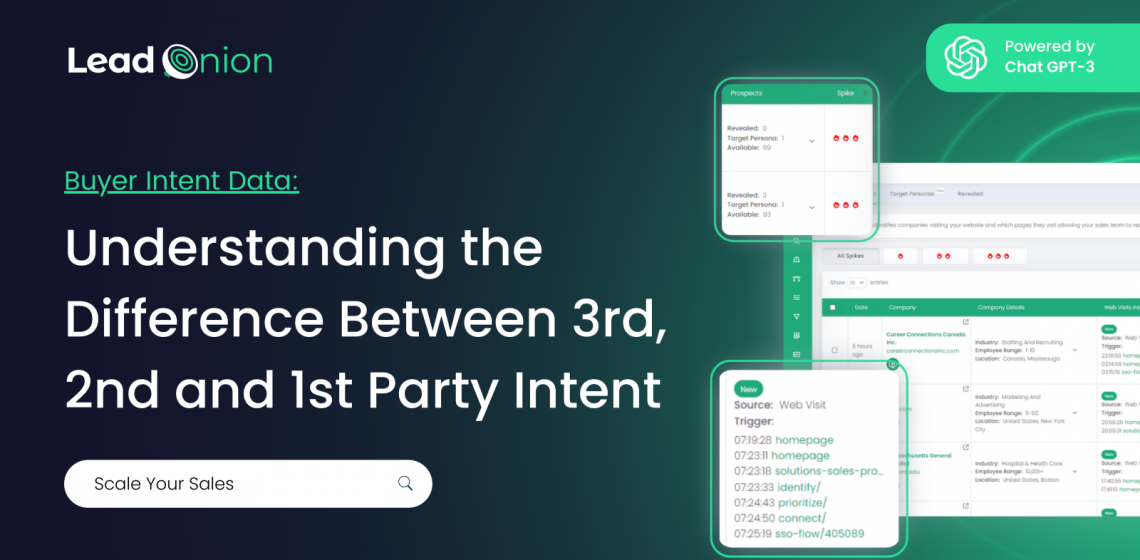Understanding the nuances between different types of intent data can make or break your strategy. Intent Data, at its core, is information that indicates a potential customer's interest or readiness to purchase.
However, not all intent data is created equal. Knowing the difference between 3rd, 2nd, and 1st Party Intent Data can significantly impact how you approach your audience and optimize your campaigns.
1. What is 1st Party Intent Data?
1st Party Intent Data is the most direct and reliable type of intent data you can gather. This data is collected from your own sources, such as your website. It includes information like:
Website Visits: Tracking user behavior on your site, such as page views, time spent on specific pages, and conversion actions like form submissions or downloads.
Online Interactions: Engagements across social media, email campaigns, and other digital touchpoints provide insights into how your audience interacts with your brand.
Offline Interactions: Data from industry events, tradeshows, and in-person meetings contribute to understanding customer intent beyond digital channels.
Since 1st Party Data is collected directly from your customers or prospects, it’s highly accurate and specific to your business. This type of data allows you to understand your audience's behavior and preferences in a granular way, making it invaluable for personalizing your marketing efforts and improving customer retention.
.png)
1st Party Intent Data is incredibly valuable due to its high accuracy and relevance. Since it is collected directly from your own sources, such as website interactions, this data offers precise insights into your audience's behavior and preferences. It allows you to create highly personalized marketing campaigns, tailoring your messaging and offers to the specific needs and interests of your prospects and customers.
Additionally, because you control the collection and usage of this data, it ensures compliance with privacy regulations and strengthens customer trust.
2. What is 2nd Party Intent Data?
2nd Party Intent Data is essentially someone else's 1st Party Data that is shared with you. This data is typically gathered from a trusted partner or platform with which you have a direct relationship. For example:
Review Sites (e.g., G2): Data from platforms like G2 is incredibly valuable but can be challenging to operationalize. Since it’s often focused on company-level insights, it may need to be supplemented with contact-level information to target the right decision-makers.
Content Distribution Networks (e.g., ContentGine): Unlike broader company-level data, platforms like ContentGine provide contact-level data, offering more granular insights into specific individuals showing intent.

By leveraging second-party data, you can gain insights into potential customers who have shown intent through interactions with complementary brands or platforms, helping you identify new prospects who might be interested in your offerings. Additionally, this data can enhance your existing first-party data by providing a broader view of your target market.
3. What is 3rd Party Intent Data?
3rd Party Intent Data is collected by external companies, often data aggregators, who gather information from various sources like websites, social media platforms, and other online interactions. This data is then sold to other companies for marketing purposes. 3rd Party Data is usually aggregated on a large scale, offering insights into broader market trends and behaviors. Examples are:
Keyword and Topic Mentions: Monitoring mentions of specific keywords or topics across blogs, forums, and B2B publishers can reveal emerging trends and competitive intelligence.
Competition: Insights from competitor analysis on external platforms provide context on how your brand is perceived relative to others.
Public Data from Social Media Networks: Data from platforms like LinkedIn, gathered from public profiles and interactions, can be a rich source of intent signals.

3rd Party Intent Data allows you to gain a comprehensive view of market behavior, helping you to identify and target new segments that may not be visible through your first or second-party data. It can also be a valuable tool for scaling your marketing efforts, as it provides access to a larger pool of potential leads.
The Importance of Combining Intent Data Types
While each type of intent data has its strengths and weaknesses, the real power lies in combining them. By integrating 1st, 2nd, and 3rd Party Intent Data, you can create a more complete picture of your target audience.
For example, 1st Party Data gives you deep insights into direct insights into those prospects who may already know who you are, 2nd Party Data helps you reach new but related audiences, and 3rd Party Data provides broader market context.
Lead Onion's stands out against the crowd by bringing together intent data from over 20 different sources across 1st, 2nd and 3rd parties—all under one roof.
This extensive integration ensures that you have access to the most comprehensive and accurate insights available, drawing from your own digital properties, trusted partners, and a vast array of external sources.
By identifying significant spikes across various sources of intent, Lead Onion’s Research Surge feature enables you to target the accounts and individuals who are most engaged and actively in-market.
.png)
This holistic approach ensures you’re not just casting a wide net but strategically focusing on high-intent prospects, optimizing your outreach, and driving higher conversion rates by connecting with the right people at the right time.
Remember, not all intent is equal, but by using the right mix, you can create a powerful strategy that drives meaningful results.
Sign up to Lead Onion's Intent Generator and try it out for FREE for 7 days!


